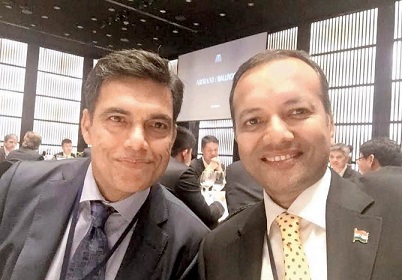By Our Correspondent
NEW DELHI/BHUBANESWAR/BARBIL: Jindal Brothers read Sajjan Jindal of JSW Steel and Naveen Jindal of Jindal Steel and Power Ltd seems playing their cards not only in Union Mines and Steel Ministries led by Prahallad Joshi and Dharmendra Pradhan but also well in the Prime Minister’s Office, led by Narendra Modi, well placed sources said on Tuesday.
The proposed reforms in mining and coal sectors seems aimed at only providing a freehand to JSW and JSPL in India’s Steel and Mining Sectors, sources known the development alleged. The Jindal Brothers had own half dozen of the 21 mines put for auction, all most all, big size reserve, iron ore blocks in Odisha’s mineral rich Joda-Koira circles of Sundargarh-Keonjhar in the last bidding by paying huge premium to Naveen Patnaik led Government in the eastern Indian State of Odisha. The Jindal brothers largely benefited after the Modi Government brought Mines and Minerals (Amendment) Act of 2015 and Mineral and Minerals (Regulation Bill)-2020 paving way for open bidding. JSW Steel’s Sajjan had himself said soon after auction, that the company can afford high premium for raw material security to run multiple operations across the Country.
The Ministry of Mines plan to delete the 10A (2b and 2c) Sections from the Mines and Minerals Development Regulation (MMDR) Act and also mulling over removal of the definition of captive and non-captive mines, will not only hit Gold Mining, iron, ore, coal mining, Steel market, but also, particularly mineral bearing Odisha, will face the onslaught with Steel makers and mines owners expressing apprehensions over the issue of captive and non-captive mines.This was reportedly aimed at providing a free hand to Jindal Brothers read Sajjan Jindal of JSW Steel and Naveen Jindal of Jindal Steel and Power Ltd .
People having close watch on Odisha’s Mining and Industry issues, however revealed that the provision of section 10(A)2 B and C was inserted in MMDR Amendment Act 2015 to safe guard the interest of ML/PL holders whose cases were pending with different State Government at that time .
These applications were filed long back as per the prevalent act as applicable in that time. Due to crawling process of government machineries these applications could not be converted in to mining leases in time bound manner. When some massive changes took place on January 12, 2015, the interest of these cases were well safeguarded by bringing the provisions of 10 A2B and 2 C. Though there was a time limit of 2 years in case of 10 A 2C but no time line was fixed in case of 10 A 2B, they said.
Different state govt kept pending all cases of 10 A 2 B for almost 5 years and no conclusive decision was taken over these cases. Now by just one stroke of pen all these cases will be scraped.
In these last 5 years, government kept a blindfold over these cases, which is why the cases couldn’t be processed timely. If Central govt didn’t want to allot these cases on mere royalty basis then why government kept these cases in saving clause under 10 A2 B in MMDR Act 2015.Those applicants have put lot of money, time and efforts to keep their respective cases alive and waited for almost 5 years after enactment of amended act, they argued.
Now government want to allot all these blocks through auction process ,as the recent auction held in Odisha fetched very attractive premium and this has completely changed the mind set of state and central government. The second case pertaining to early termination of validity of captive mines by 5 years. The captive mining leases coming under 8A5 category were extended by almost 15 years ie upto 31.03.2030 mainly belonging to Tatas . Now early termination of the captive mines and scraping the provisions of right of first refusal creates lot of doubt at this stage, one of the Koira , Sundargarh based Mines owner said .
Recently Some mega steel companies mainly rivals of Tisco , like JSW Steel, Jindal Steel and Power Ltd, Arcellor-Mittal India and few more have grabbed several big size iron ore mines in Odisha though auction .Now they are thinking that in future they may not be able to compete with Tisco ,because they have taken mines @ more than 100% premium whereas TISCO will enjoy it’s mines for another 10 years on simple royalty basis.That’s why they may not be able to compete with Tisco in long run, they said.
For instance suppose if the IBM price of 1MT of iron ore is Rs 3,000 pmt, the auctioneers have to pay 3,000 plus royalty etc.If cost of production will be added with this premium and royalty it will be around 4,500 pmt(3,000 amount of premium (@100%,) Rs 700 royalty DMF etc 800 tentative cost of production.)
For 1 mt of iron ore the auctioned miners have to pay around Rs 4,500. On contrary Tisco will have to bear only Rs 1,500 towards royalty and cost of production, they said.
For making 1 mt of steel almost 2 mt of iron ore is required. Simply Rs 6,000 per mt extra cost will be borned by these auctioned miners for steel making where as Tisco having vast advantages of its infrastructures like Raliway siding and mining leases of coal,lime stone,Dolomite etc and less cost of production , long period in hand having extra edge over their competitors. In event of depressed market sentiments where the profit in steel will be less than 6,000 pmt even after Tisco can make some profit but their competitors will have to suffer the losses. Therefore these extra facilities of Tata has became a point of envy for their rivals. By hook or crook they don’t want to see Tisco to enjoy furthermore, sources added.
It is worth mentioning that Tisco since its inception has always believed in fair working in very disciplined manner always doing a lot for weaker section of the society , in fact when there was no CSR activities undertaken by other companies it was Tisco who always provided good medical facilities to the society. TSRDS is taking all care of people and nature protection in rural areas.
Section 10A (2) (b) allowed an entity to acquire a mining lease for the mines allotted prior to auction regime without any sunset clause and 10A (2) (c) allowed an entity to get the environment and forest clearance within 2 years of the auction of mines. There is a proposal is to define illegal mining under the MMDR Act. In the past, like in the case of Coal India, violation of environment/forest clearance has led to the state government of Odisha seek fine in the tune of Rs 20,000 crore in 2017 including around Rs 900 crore of Jindal Steel and Power Ltd and Sarda Mines Pvt Ltd over violation of Rule 37 and others acts. The amendment will clarify that mining within the mining lease area cannot be illegal under Section 21 (5) of the MMDR Act,
The Ministry had reportedly suggested bringing in early termination of captive leases from 2030 to 2025 and auction such mines without any first right of refusal. Another bold move that is being considered is that of transferring mines seamlessly whether it has been auctioned or allotted by the government. Under the current norms, only auctioned mines can be transferred and for non-captive mines, a transfer charge is levied equivalent to 80 percent royalty.
The resignation of TV Narendra, as President of Indian Steel Association, was an outcome of Tata Group’s concerns over captive and non-captive mines issues in the wake of media reports on mining and coal sectors facing reforms soon, sources said. TV Narendra is chief executive and managing director of Tata Steel. Earlier, several Gold mines owners in Karnataka had expressed their concerns on issues of 10A (2b and 2c) Sections from the Mines and Minerals Development Regulation (MMDR) Act as they feared huge loss since they invested crores in explorations in past 15 years and an open auction for the same gold bearing block, would put them in trouble.
Narendran was the President of the Association, which has representation from leading steel producers including JSW Steel, SAIL, Rashtriya Ispat Nigam, Jindal Steel and Power, Bhushan Power and Steel, Tata Steel BSL and ArcelorMittal. His two-year tenure was to end in August. Tata Steel has large captive mines spread across Jharkhand and Odisha feeding its plants at Jamshedpur, Kalinganagar and Angul. It also mines ferro alloys such as chromite and manganese for captive use.In FY19, the company mined 23.3 million tonnes of iron ore and 6.54 million tonnes of coal, meeting 100 per cent and 27 per cent of its requirements, respectively.
The FICCI had however while supporting the move, welcomed the proposed reforms in coal and mining sector by saying these measures will give a push towards government’s efforts for improving efficiencies in coal sector for augmenting domestic coal production and reducing the cost of power for the consumers. These measures will also help the government pursue its objective of attaining sustainable development growth plans, Vipul Tuli, FICCI Power Committee Chairman, had said soon after media reports.
The ministry had also suggested that no mine should be auctioned as captive in future, doing away with the distinction between captive and merchant altogether. The auctions of iron ore and manganese mines in Odisha in January and February fetched an average premium of about 105%. That means, in addition to taxes and cess, a lessee would also pay the state Rs 105 for every Rs 100 of ore it sold over the next fifty years. Taking prevalent iron ore prices and everything else as constant, this works out to an additional annual revenue of about Rs 7,000 crore for the state, a report in The Economic Times said.
The 2015 amendment made two exceptions: Under Section 10A (2b) where reconnaissance or prospecting had been carried out successfully, the lessee could move up to a prospecting or mining lease respectively. Ironically, subsection 2c offered a window of two years, or until January 12, 2017, to those that had progressed beyond and held a letter of intent.
Royalty is charged on price inclusive of royalty because miners pass on the cost anyway. Any discounting of this would lead to a loss of revenue for the state. New lessees have offered premiums of five to six times of royalty presumably because they could afford to.
Auctioning of additional blocks, reduction in cost of mining and transportation, increasing ease of doing business, participation of private sector in exploration and mining and use of sea-routes for domestic supplies will be some of the next wave of reforms being planned by the Government for bringing in more investments, increasing employment opportunities and towards substituting imported coal with inventory of domestic coal with an objective of securing the country’s energy needs, he added.
Under these 2 provisions of MMDR Act, about 600 mines are stuck and the idea is to get these mines for auction. The ministry also intends to return mines held with PSUs for more than 3 years where mining is yet to begin and other non-operational mines to the state government for auction.
The tax burden has been at a higher range in India for mining, the ministry intends to simplify royalty calculation and plans to bring an amendment to the Act. The amendment will allow calculation of royalty which will exclude taxes and levies.Discussion is also being held with the finance ministry on levy of the stamp duty in a calibrated manner instead of the entire lease period of 50 years at one go. All levies and royalty are calculated on the average sale price which ministry believes, is not the actual representative of actual mineral price and hence it plans to bring a national mineral index.
In the coal sector, the ministry had already enabled the provision for auction of coal mines for commercial sale but final rules for the auction are yet to be formulated as COVID-19 delayed the beginning of the auction process starting April 2020. The ministry is also looking at including a revenue-sharing model for auction of coal to boost production, enable single-window clearances, and reduce dependence on imported coal.The focus of the government is to bring big reforms in the coal and mining sector to kickstart the economy which has been majorly impacted due to a long spell of lockdown on account of coronavirus spread.
Sources said that Ministry of Mines is looking at doubling employment from the current one crore to two crore and even double GDP contribution from Rs 4.1 lakh crore to Rs 8 lakh crore by 2024. The ministry has mooted for pre-embedded clearances for successful bidders as it requires 20 statutory clearances which take 2-3 years to obtain. The proposal is for the states to obtain clearances prior to the auction which will be transferred to the winning bidder. The ministry is already monitoring pilot projects in four states where mines are auctioned with pre-embedded clearances.






























